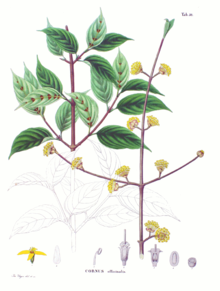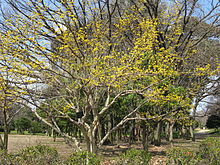| Cornus officinalis | |
|---|---|

| |
| Scientific classification | |
| Kingdom: | Plantae |
| Clade: | Tracheophytes |
| Clade: | Angiosperms |
| Clade: | Eudicots |
| Clade: | Asterids |
| Order: | Cornales |
| Family: | Cornaceae |
| Genus: | Cornus |
| Subgenus: | Cornus subg. Cornus |
| Species: | C. officinalis
|
| Binomial name | |
| Cornus officinalis | |

Cornus officinalis, the Japanese cornel or Japanese cornelian cherry,[1] is a species of flowering plant in the dogwood family Cornaceae. Despite its name, it is native to China and Korea as well as Japan.[2] It is not to be confused with C. mas, which is also known as the Cornelian cherry. It is not closely related to the true cherries of the genus Prunus.
Description[edit]
It is a large, strongly-growing deciduous shrub with rough flaky bark. Umbels of acid yellow flowers appear in early spring before the oval leaves. The red berries, which are edible, appear later in the summer, and the leaves turn shades of red before falling in the autumn.[3]
Etymology[edit]
In Korean it is known as sansuyu (산수유), in Chinese as shān zhū yú (山茱萸) and in Japanese as sanshuyu (さんしゅゆ).
The Latin specific epithet officinalis refers to plants which have some medicinal or culinary use - in this case the edible berries.[4]
Cultivation[edit]
The plant is valued in cultivation for providing year-round interest in the garden. It is, however, quite a substantial shrub, typically growing to 8 m (26 ft) tall and broad. The cultivar 'Kintoki', with larger and more abundant flowers, has won the Royal Horticultural Society's Award of Garden Merit.[5][6]
Herbalism[edit]
It occurs in China, Japan and Korea where it is used as a food plant and as a medicinal plant.
Chemical constituents[edit]
The plant contains oleanolic acid and ursolic acid.[7] Ursolic acid has shown in vitro protective effects on auditory cells.[8]
Ethanolic extracts of the fruit of C. officinalis has been shown to prevent hepatic injuries associated with acetaminophen-induced liver injury-induced hepatotoxicity (in mice) by preventing or alleviating oxidative stress.[9]
The chemical constituents isolated from the fruit (Corni fructus) have protective effects on beta cells in vitro,[10][11] and may control postprandial hyperglycemia by alpha-glucosidase inhibition.[12]
Cornel iridoid glycoside, a chemical extracted from Cornus officinalis, promoted neurogenesis and angiogenesis and improved neurological function after ischemia in rats.[13]
Morroniside, the most abundant iridoid glycoside extracted from Cornus officinalis, substantially reduces osteophyte formation and subchondral sclerosis in mice models. Specifically, morroniside significantly promotes cartilage matrix synthesis by increasing collagen type II expression and suppressing chondrocyte pyroptosis. It inhibits matrix metalloproteinase-13 (MMP13), Caspase-1 and nod-like receptor protein-3 (NLRP3) expression in DMM mice and IL-1β-stimulated chondrocytes, and enhances chondrocyte proliferation and inhibits chondrocyte apoptosis.[14] It also slows OA progression by inhibiting nuclear factor-κB (NF-κB) signaling.[15]
A randomized, double-blinded, placebo-controlled study found that a Chinese herbal formula that mainly consisted of Cornus officinalis was not only effective at improving erectile function, but it was also safe for the treatment of erectile dysfunction.[16] A chemical substance isolated from Cornus officinalis also may enhance the motility of human sperm.[17]
Cell cultures of C. officinalis contain gallotannins in the forms of tri-, tetra- and pentagalloylglucoses. The main tannins are 1,2,3,6-tetragalloylglucose, 1,2,6-trigalloyl-glucose, 1,2,3,4,6-pentagalloyl-glucose and 6-digalloyl-1,2,3-trigalloyl-glucose.[18]
Nutrition[edit]
Cornelian cherry juices are rich in potassium, calcium, sodium, iron, zinc, manganese, and copper. Compared to other juices obtained from plum, pear, and apple, Cornelian cherry juice contained higher levels of dietary minerals.[19]
Gallery[edit]
-
trunk
-
bush
-
leaves
-
flowers
-
flowers
References[edit]
- ^ "Cornus officinalis". Germplasm Resources Information Network. Agricultural Research Service, United States Department of Agriculture.
- ^ "Cornus officinalis". Flora of China – via eFloras.org, Missouri Botanical Garden, St. Louis, MO & Harvard University Herbaria, Cambridge, MA.
- ^ "Cornus officinalis". www.rhs.org. Royal Horticultural Society. Retrieved 8 February 2020.
- ^ Harrison, Lorraine (2012). RHS Latin for Gardeners. United Kingdom: Mitchell Beazley. ISBN 978-1845337315.
- ^ "Cornus officinalis 'Kintoki'". www.rhs.org. Royal Horticultural Society. Retrieved 8 February 2020.
- ^ "AGM Plants - Ornamental" (PDF). www.rhs.org. Royal Horticultural Society. July 2017. p. 107. Retrieved 8 February 2020.
- ^ Wang, R; Wang, SM; Liang, SW; Xu, GW; Weng, QF (August 2007). "胶束电动毛细管色谱法分离分析山茱萸中齐墩果酸和熊果酸" [Separation and determination of oleanolic acid and ursolic acid from Cornus officinalis by capillary electrophoresis]. Journal of Chinese Medicinal Materials (in Chinese). 30 (8): 946–50. PMID 18074841.
- ^ Yu, Hyeon-Hee; Hur, Jong-Moon; Seo, Se-Jeong; Moon, Hae-Dalma; Kim, Hyun-Jin; Park, Rae-Kil; You, Yong-Ouk (January 2009). "Protective Effect of Ursolic Acid from Cornus officinalis on the Hydrogen Peroxide-Induced Damage of HEI-OC1 Auditory Cells". The American Journal of Chinese Medicine. 37 (4): 735–746. doi:10.1142/S0192415X0900720X. PMID 19655411.
- ^ Lee, Nam-Hun; Seo, Chang-Seob; Lee, Ho-young; Jung, Da-Young; Lee, Jun-Kyung; Lee, Jin-Ah; Song, Kye Yong; Shin, Hyeun-kyoo; Lee, Mee-Young; Seo, Young Bae; Kim, Hokyoung; Ha, Hyekyung (2012). "Hepatoprotective and Antioxidative Activities of Cornus officinalis against Acetaminophen-Induced Hepatotoxicity in Mice". Evidence-Based Complementary and Alternative Medicine. 2012: 804924. doi:10.1155/2012/804924. PMC 3159024. PMID 21869901.
- ^ Lin, Mei-Hsiang; Liu, Hui-Kang; Huang, Wei-Jan; Huang, Chu-Chun; Wu, Tzu-Hua; Hsu, Fen-Lin (27 July 2011). "Evaluation of the Potential Hypoglycemic and Beta-Cell Protective Constituents Isolated from Corni Fructus To Tackle Insulin-Dependent Diabetes Mellitus". Journal of Agricultural and Food Chemistry. 59 (14): 7743–7751. doi:10.1021/jf201189r. PMID 21682333.
- ^ Park, Chan Hum; Noh, Jeong Sook; Tanaka, Takashi; Cho, Eun Ju; Yokozawa, Takako (1 May 2009). "Novel action of 7-O-galloyl-D-sedoheptulose isolated from Corni Fructus as a hypertriglyceridaemic agent". Journal of Pharmacy and Pharmacology. 61 (5): 653–661. doi:10.1211/jpp/61.05.0015 (inactive 2024-02-18). PMID 19406005.
{{cite journal}}: CS1 maint: DOI inactive as of February 2024 (link) - ^ Park, Chan Hum; Noh, Jeong Sook; Tanaka, Takashi; Uebaba, Kazuo; Cho, Eun Ju; Yokozawa, Takako (January 2011). "The Effects of Corni Fructus Extract and Its Fractions Against α-Glucosidase Inhibitory Activities in Vitro and Sucrose Tolerance in Normal Rats". The American Journal of Chinese Medicine. 39 (2): 367–380. doi:10.1142/S0192415X11008889. PMID 21476212.
- ^ Yao, R. -Q.; Zhang, L.; Wang, W.; Li, L. (6 April 2009). "Cornel iridoid glycoside promotes neurogenesis and angiogenesis and improves neurological function after focal cerebral ischemia in rats". Brain Research Bulletin. 79 (1): 69–76. doi:10.1016/j.brainresbull.2008.12.010. PMID 19150488. S2CID 206340102.
- ^ Park, Eunkuk; Lee, Chang Gun; Han, Seong Jae; Yun, Seung Hee; Hwang, Seokjin; Jeon, Hyoju; Kim, Jeonghyun; Choi, Chun Whan; Yang, Siyoung; Jeong, Seon-Yong (15 March 2021). "Antiosteoarthritic Effect of Morroniside in Chondrocyte Inflammation and Destabilization of Medial Meniscus-Induced Mouse Model". International Journal of Molecular Sciences. 22 (6): 2987. doi:10.3390/ijms22062987. PMC 7999654. PMID 33804203.
- ^ Yu, Huan; Yao, Sai; Zhou, Chengchong; Fu, Fangda; Luo, Huan; Du, Weibin; Jin, Hongting; Tong, Peijian; Chen, Di; Wu, Chengliang; Ruan, Hongfeng (February 2021). "Morroniside attenuates apoptosis and pyroptosis of chondrocytes and ameliorates osteoarthritic development by inhibiting NF-κB signaling". Journal of Ethnopharmacology. 266: 113447. doi:10.1016/j.jep.2020.113447. PMID 33022338. S2CID 222183646.
- ^ Kam, Sung-Chul; Choi, See-Min; Jeh, Sung-Uk; Lee, Seung-Hyun; Hwa, Jeong-Seok; Jung, Ky-Hyun; Kang, Chang-Wan; Hyun, Jae-Seog (2007). "산수유 복합 추출 분말이 발기 부전증 환자에 미치는 임상적 효과와 안전성" [Efficacy and Safety of a Herbal Formula that Mainly Consists of Cornus Officinalis for Erectile Dysfunction: A Double-blind, Placebo-controlled Study]. Investigative and Clinical Urology (in Korean). 48 (7): 741–747.
- ^ Jeng, Hellen; Wu, Chao Mei; Su, Shuen-Jiing; Chang, Wen-Chang (January 1997). "A Substance Isolated from Cornus officinalis Enhances the Motility of Human Sperm". The American Journal of Chinese Medicine. 25 (3n04): 301–306. doi:10.1142/S0192415X97000330. PMID 9358903.
- ^ Yazaki, K.; Okuda, T. (1989). "Gallotannin production in cell cultures ofCornus officinalis Sieb. et Zucc". Plant Cell Reports. 8 (6): 346–349. doi:10.1007/BF00716670. PMID 24233272. S2CID 38051721. INIST 7353523.
- ^ Krośniak, M.; Gąstoł, M.; Szałkowski, M.; Zagrodzki, P.; Derwisz, M. (30 July 2010). "Cornelian Cherry (Cornus mas L.) Juices as a Source of Minerals in Human Diet". Journal of Toxicology and Environmental Health, Part A. 73 (17–18): 1155–1158. Bibcode:2010JTEHA..73.1155K. doi:10.1080/15287394.2010.491408. PMID 20706938. S2CID 19868002.




